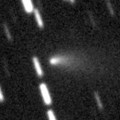
|
Now it is very bright as 10.3 mag (Dec. 27, Katsumi Yoshimoto). It is approaching to Earth down to 0.2 a.u. now. In the Northern Hemisphre, it stays observable in good condition until January, but it will be extremely low after that. In the Southern Hemisphere, it is not observable from January to mid March, but it stays observable in good condition except for that period.
Date(TT) R.A. (2000) Decl. Delta r Elong. m1 Best Time(A, h)
Dec. 30 8 2.96 34 37.9 0.277 1.245 157 10.9 1:33 ( 0, 88)
Jan. 6 4 4.99 68 14.0 0.226 1.133 126 10.2 20:25 (180, 56)
|

|
Now it is very bright as 10.4 mag (Dec. 15, Marco Goiato). It is observable in good condition in the Northern Hemisphere. It locates low in the Southern Hemisphere. It will be fading after January.
Date(TT) R.A. (2000) Decl. Delta r Elong. m1 Best Time(A, h)
Dec. 30 13 10.54 3 52.6 1.206 1.468 83 10.9 5:37 (333, 56)
Jan. 6 13 26.49 3 6.2 1.187 1.496 86 11.1 5:38 (339, 56)
|
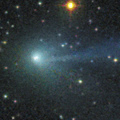
|
Now it is bright as 10.7 mag (Dec. 27, Katsumi Yoshimoto). It will stay bright as 11 mag for a long time until spring. In the Southern Hemisphere, it stays observable in good condition until February. In the Northern Hemispehre, it stays observable for a long time after this until the comet fades out.
Date(TT) R.A. (2000) Decl. Delta r Elong. m1 Best Time(A, h)
Dec. 30 4 26.43 13 32.6 2.063 2.943 147 11.3 21:50 ( 0, 69)
Jan. 6 4 18.51 15 37.3 2.089 2.910 139 11.2 21:14 ( 0, 71)
|

|
It brightened up to 8.1 mag in autumn (Oct. 3, Juan Jose Gonzalez). Now it is fading. It has already faded down to 12.2 mag (Dec. 23, Carlos Labordena). It is observable all night in the Northern Hemisphere. In the Northern Hemisphere, it stays observable in excellent condition for a long time. In the Southern Hemisphere, it will never be observable again after this.
Date(TT) R.A. (2000) Decl. Delta r Elong. m1 Best Time(A, h)
Dec. 30 23 56.70 85 44.3 1.213 1.829 112 12.0 18:28 (179, 39)
Jan. 6 0 39.95 85 29.4 1.281 1.884 111 12.3 18:32 (179, 39)
|
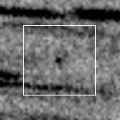
|
Now it is 15.8 mag (Dec. 17, Ken-ichi Kadota). It will brighten very rapidly, and brighten up to 11 mag from January to February. In the Northern Hemisphere, it stays observable for a long time in the evening sky. In the Southern Hemisphere, it locates extremely low at the highlight.
Date(TT) R.A. (2000) Decl. Delta r Elong. m1 Best Time(A, h)
Dec. 30 21 19.19 -9 51.4 1.534 1.025 41 12.8 18:28 ( 61, 21)
Jan. 6 21 47.58 -8 46.5 1.491 0.987 40 12.3 18:32 ( 62, 21)
|

|
Now it is 12.0 mag (Dec. 18, Seiichi Yoshida). It is observable in good condition in the Northern Hemisphere. It locates very low for a long time in the Southern Hemisphere. It will be fading after this.
Date(TT) R.A. (2000) Decl. Delta r Elong. m1 Best Time(A, h)
Dec. 30 14 35.75 -4 22.0 1.496 1.330 60 12.4 5:37 (312, 38)
Jan. 6 14 54.85 -5 47.5 1.502 1.369 62 13.0 5:38 (315, 38)
|

|
It brightened up to 7.1 mag from May to June (June 21, Juan Jose Gonzalez). Now it is fading. It has already faded down to 13.5 mag (Dec. 7, Chris Wyatt). In the Southern Hemisphere, it stays observable for a long time after this. It will never be observable again in the Northern Hemisphere.
Date(TT) R.A. (2000) Decl. Delta r Elong. m1 Best Time(A, h)
Dec. 30 20 57.95 -54 47.6 3.671 3.001 41 13.1 18:28 ( 31,-14)
Jan. 6 21 17.05 -54 3.2 3.756 3.068 39 13.3 18:32 ( 33,-15)
|

|
Now it is 13.6 mag (Dec. 18, Toshihiko Ikemura, Hirohisa Sato). It is expected to brighten up to 12 mag from 2018 to 2019. In the Northern Hemisphere, it stays observable in good condition while the comet will be brightening gradually. In the Southern Hemisphere, it is not observable until 2018 October.
Date(TT) R.A. (2000) Decl. Delta r Elong. m1 Best Time(A, h)
Dec. 30 15 41.31 52 47.9 3.314 3.372 84 13.5 5:37 (228, 49)
Jan. 6 15 44.29 54 39.7 3.207 3.330 88 13.3 5:38 (224, 53)
|

|
Now it is 14.7 mag (Dec. 15, Toshihiko Ikemura, Hirohisa Sato).
Date(TT) R.A. (2000) Decl. Delta r Elong. m1 Best Time(A, h)
Dec. 30 21 33.98 -11 57.8 6.472 5.801 43 13.8 18:28 ( 56, 22)
Jan. 6 21 38.77 -11 31.1 6.545 5.800 37 13.8 18:32 ( 62, 17)
|
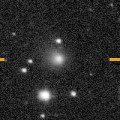
|
Now it is 13.7 mag (Nov. 14, Gabor Santa). It is expected to brighten up to 10 mag in summer in 2018. In the Northern Hemisphere, it stays observable until 2018 summer while the comet will be brightening. However, it will be extremely low from December to January. In the Southern Hemisphere, it is hardly observable in 2017, but it will be observable in good condition in 2018.
Date(TT) R.A. (2000) Decl. Delta r Elong. m1 Best Time(A, h)
Dec. 30 18 15.50 8 24.9 4.110 3.317 31 14.0 5:37 (262, 4)
Jan. 6 18 22.44 7 23.8 4.057 3.264 31 13.9 5:38 (266, 8)
|

|
Now it is 14.0 mag (Dec. 13, Chris Wyatt). It stays 14 mag for a while. In the Southern Hemisphere, it stays observable in good condition until spring in 2018. It is getting higher gradually also in the Northern Hemisphere.
Date(TT) R.A. (2000) Decl. Delta r Elong. m1 Best Time(A, h)
Dec. 30 1 45.33 -45 42.1 1.836 2.003 84 14.1 19:10 ( 0, 10)
Jan. 6 1 52.51 -40 43.1 1.858 2.003 83 14.1 18:49 ( 0, 15)
|

|
Now it is 14.2 mag (Nov. 14, Artyom Novichonok). It will be observable at 14 mag for a long time from 2017 to 2018. In the Southern Hemisphere, it will be hardly observable after this. It will be extremely low from November to December in the Northern Hemisphere.
Date(TT) R.A. (2000) Decl. Delta r Elong. m1 Best Time(A, h)
Dec. 30 16 31.73 22 48.7 4.234 3.757 55 14.4 5:37 (263, 32)
Jan. 6 16 33.77 23 57.8 4.152 3.750 59 14.4 5:38 (266, 39)
|
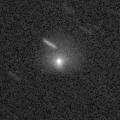
|
Brian Skiff found a bright outburst on Dec. 7. It brightened up to 13.2 mag (Dec. 11, Seiichi Yoshida). It stays bright as 13.3 mag still now (Dec. 20, Toshihiko Ikemura, Hirohisa Sato). This is the 4th outburst following those in January 2006, May 2011 and August 2016. It stays observable in good condition for a while.
Date(TT) R.A. (2000) Decl. Delta r Elong. m1 Best Time(A, h)
Dec. 30 2 35.62 11 15.6 6.785 7.350 121 15.1 20:00 ( 0, 66)
Jan. 6 2 35.29 11 16.4 6.904 7.368 114 15.4 19:32 ( 0, 66)
|
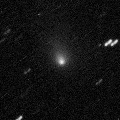
|
It brightened very rapidly up to 13.8 mag in August (Aug. 22, kunihiro Shima). After that, it is fading gradually. Now it is 15.0 mag (Dec. 19, Martin Masek). It is observable in excellent condition in the Southern Hemisphere. It stays low for a while in the Northern Hemisphere.
Date(TT) R.A. (2000) Decl. Delta r Elong. m1 Best Time(A, h)
Dec. 30 0 16.44 -19 24.8 2.378 2.381 78 15.3 18:28 ( 13, 35)
Jan. 6 0 23.85 -17 20.1 2.434 2.358 73 15.4 18:32 ( 21, 35)
|
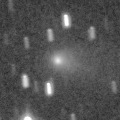
|
Now it is 15.6 mag (Dec. 19, Toshihiko Ikemura, Hirohisa Sato). It brightened rapidly. It is observable in good condition in the Northern Hemisphere. It locates low in the Southern Hemisphere.
Date(TT) R.A. (2000) Decl. Delta r Elong. m1 Best Time(A, h)
Dec. 30 5 3.64 40 10.6 1.259 2.187 154 15.4 22:27 (180, 85)
Jan. 6 5 0.18 39 54.4 1.320 2.217 148 15.5 21:56 (180, 85)
|
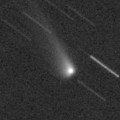
|
Now it is 15.6 mag (Dec. 13, Toshihiko Ikemura, Hirohisa Sato). It stays observable at 15-16 mag for a long time from 2017 to 2018.
Date(TT) R.A. (2000) Decl. Delta r Elong. m1 Best Time(A, h)
Dec. 30 0 11.70 0 8.6 4.248 4.268 84 15.4 18:28 ( 22, 53)
Jan. 6 0 10.78 -0 41.3 4.385 4.270 76 15.5 18:32 ( 34, 49)
|
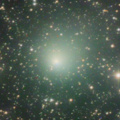
|
It brightened up to 10 mag from spring to summer. Now it is fading. It has already faded down to 14.7 mag (Dec. 13, Thomas Lehmann). It is observable in excellent condition in the Southern Hemisphere. It locates low in the Northern Hemisphere.
Date(TT) R.A. (2000) Decl. Delta r Elong. m1 Best Time(A, h)
Dec. 30 22 28.75 -17 22.2 2.690 2.267 54 15.8 18:28 ( 41, 26)
Jan. 6 22 41.59 -15 50.3 2.795 2.305 50 16.0 18:32 ( 47, 25)
|

|
Now it is 15.0 mag (Nov. 22, Sandor Szabo). It stays 17 mag in 2018.
Date(TT) R.A. (2000) Decl. Delta r Elong. m1 Best Time(A, h)
Dec. 30 3 13.15 -1 5.8 5.766 6.382 125 15.9 20:37 ( 0, 54)
Jan. 6 3 12.59 -0 55.4 5.886 6.413 118 15.9 20:09 ( 0, 54)
|
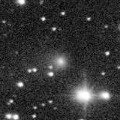
|
Now it is 15.3 mag (Dec. 17, Toshihiko Ikemura, Hirohisa Sato). It will be fading after this. In the Northern Hemisphere, it stays observable in the northern sky for a long time. It is not observable at all after this in the Southern Hemisphere.
Date(TT) R.A. (2000) Decl. Delta r Elong. m1 Best Time(A, h)
Dec. 30 20 5.30 62 12.0 3.252 3.352 87 15.9 18:28 (146, 38)
Jan. 6 20 11.98 62 39.5 3.291 3.372 86 15.9 18:32 (147, 35)
|

|
Now it is 16.5 mag (Dec. 18, Toshihiko Ikemura, Hirohisa Sato). It stays 16-17 mag for a long time from 2016 to 2019. It stays near by the equator.
Date(TT) R.A. (2000) Decl. Delta r Elong. m1 Best Time(A, h)
Dec. 30 10 34.32 4 10.1 9.054 9.576 119 15.9 4:01 ( 0, 59)
Jan. 6 10 34.05 4 19.3 8.959 9.579 126 15.9 3:33 ( 0, 59)
|
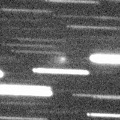
|
Now it is 15.6 mag (Nov. 22, Sandor Szabo). It stays observable at 16 mag for a long time until summer in 2018. It is observable in good condition in the Northern Hemisphere in 2017, and in the Southern Hemisphere in 2018. Mikhail Maslov reported that it looks bright as 13 mag with a large coma by his photo on Dec. 19.
Date(TT) R.A. (2000) Decl. Delta r Elong. m1 Best Time(A, h)
Dec. 30 22 58.01 25 21.1 1.620 1.742 79 16.0 18:28 ( 79, 61)
Jan. 6 22 53.38 21 5.5 1.755 1.700 70 16.0 18:32 ( 79, 52)
|
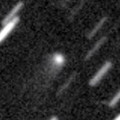
|
Now it is 15.6 mag (Dec. 13, Toshihiko Ikemura, Hirohisa Sato). It stays 16 mag for a long time from 2017 to 2018. It is observable in excellent condition in the Northern Hemisphere. It locates very low in the Southern Hemisphere.
Date(TT) R.A. (2000) Decl. Delta r Elong. m1 Best Time(A, h)
Dec. 30 8 48.67 33 10.6 4.466 5.335 149 16.0 2:16 ( 0, 88)
Jan. 6 8 40.91 34 38.5 4.424 5.338 156 16.0 1:41 ( 0, 90)
|
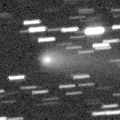
|
It brightened up to 12.2 mag in August (Aug. 21, Juan Jose Gonzalez). It is fading now. It has already faded down to 15.5 mag (Dec. 13, Toshihiko Ikemura, Hirohisa Sato).
Date(TT) R.A. (2000) Decl. Delta r Elong. m1 Best Time(A, h)
Dec. 30 7 56.54 14 33.9 1.329 2.274 159 16.0 1:24 ( 0, 69)
Jan. 6 7 48.20 15 39.1 1.360 2.331 168 16.3 0:48 ( 0, 71)
|
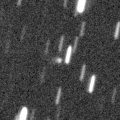
|
Now it is 16.5 mag (Dec. 15, Toshihiko Ikemura, Hirohisa Sato). It will brighten up to 9 mag in 2018 summer. However, it is hardly observable when it is bright. In the Northern Hemisphere, it is observable only until March when it brightens up to 14 mag. In the Southern Hemisphere, it is observable from July to September in 2018, but it locates in extremely low.
Date(TT) R.A. (2000) Decl. Delta r Elong. m1 Best Time(A, h)
Dec. 30 22 38.01 57 37.1 2.911 3.156 95 16.3 18:28 (144, 57)
Jan. 6 22 50.32 55 19.6 2.891 3.073 91 16.2 18:32 (139, 55)
|

|
Now it is 16.5 mag (Dec. 17, Toshihiko Ikemura, Hirohisa Sato). It will be observable at 16 mag in good condition from winter to spring.
Date(TT) R.A. (2000) Decl. Delta r Elong. m1 Best Time(A, h)
Dec. 30 11 55.50 8 28.2 3.192 3.538 102 16.4 5:22 ( 0, 63)
Jan. 6 11 58.12 8 27.7 3.093 3.537 109 16.3 4:57 ( 0, 63)
|

|
It stays 15 mag from 2018 to 2019, and it will be observable for a long time in the Southern Hemisphere. In the Northern Hemisphere, it will never be observable again.
Date(TT) R.A. (2000) Decl. Delta r Elong. m1 Best Time(A, h)
Dec. 30 13 52.63 -46 36.3 5.592 5.177 60 16.6 5:37 (343, 5)
Jan. 6 13 57.14 -48 1.3 5.476 5.141 65 16.5 5:38 (347, 5)
|
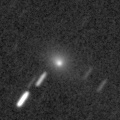
|
Return of a new periodic comet which brightened up to 13 mag in 2004. It brightened rapidly up to 14.3 mag (Nov. 15, Catalina Sky Survey). Now it is fading. It has already faded down to 16.5 mag (Dec. 17, Toshihiko Ikemura, Hirohisa Sato).
Date(TT) R.A. (2000) Decl. Delta r Elong. m1 Best Time(A, h)
Dec. 30 2 27.53 19 52.8 1.137 1.861 122 16.6 19:52 ( 0, 75)
Jan. 6 2 34.57 21 4.8 1.220 1.887 117 16.8 19:32 ( 0, 76)
|

|
Now it is 16.8 mag (Dec. 20, Toshihiko Ikemura, Hirohisa Sato). It will be observable at 16.5 mag in good condition in winter.
Date(TT) R.A. (2000) Decl. Delta r Elong. m1 Best Time(A, h)
Dec. 30 9 59.43 -10 55.7 2.287 2.902 119 16.6 3:26 ( 0, 44)
Jan. 6 9 58.50 -12 11.7 2.250 2.932 125 16.6 2:58 ( 0, 43)
|
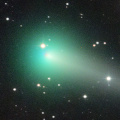
|
It brightened up to 6.2 mag in April (Apr. 7, Juan Jose Gonzalez). Now it is fading rapidly. It has already faded down to 15.5 mag (Dec. 20, Thomas Lehmann). It stays observable for a long time after this.
Date(TT) R.A. (2000) Decl. Delta r Elong. m1 Best Time(A, h)
Dec. 30 2 42.49 15 33.6 2.773 3.431 124 16.7 20:07 ( 0, 71)
Jan. 6 2 42.88 15 29.0 2.940 3.507 117 17.0 19:40 ( 0, 71)
|

|
Now it is 16.5 mag (Dec. 18, Toshihiko Ikemura, Hirohisa Sato). It will pass the perihelion in 2019. However, it has not been brightening since the discovery in 2010. It is observable in good conditioin in the Northern Hemisphere. It is not observable for a long time in the Southern Hemisphere.
Date(TT) R.A. (2000) Decl. Delta r Elong. m1 Best Time(A, h)
Dec. 30 6 22.92 76 40.8 8.187 8.807 126 16.8 23:47 (180, 48)
Jan. 6 6 14.06 76 48.5 8.190 8.796 125 16.8 23:11 (180, 48)
|
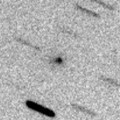
|
Now it is 17.1 mag (Dec. 21, Katsumi Yoshimoto). It stays observable at 17 mag in good condition for a while. It will be fainter than 18 mag in May.
Date(TT) R.A. (2000) Decl. Delta r Elong. m1 Best Time(A, h)
Dec. 30 14 12.17 -5 58.1 2.416 2.199 65 16.9 5:37 (319, 40)
Jan. 6 14 23.33 -6 34.6 2.369 2.230 69 16.9 5:38 (324, 42)
|

|
Now it is 16.9 mag (Dec. 13, Toshihiko Ikemura, Hirohisa Sato). It will be fading after this, and it will be fainter than 18 mag in March.
Date(TT) R.A. (2000) Decl. Delta r Elong. m1 Best Time(A, h)
Dec. 30 1 2.81 17 46.6 2.668 3.042 102 16.9 18:28 ( 0, 73)
Jan. 6 1 7.35 18 7.3 2.777 3.056 97 17.0 18:32 ( 22, 72)
|

|
Now it is 16.9 mag (Dec. 13, Toshihiko Ikemura, Hirohisa Sato). In the Northern Hemisphere, it will be observable at 17 mag in excellent condition from autumn to winter. It locates low in the Southern Hemisphere.
Date(TT) R.A. (2000) Decl. Delta r Elong. m1 Best Time(A, h)
Dec. 30 5 9.53 35 50.7 2.340 3.270 157 16.9 22:33 (180, 89)
Jan. 6 5 5.63 35 37.9 2.397 3.290 150 16.9 22:02 (180, 89)
|

|
Now it is 18.2 mag (Dec. 19, Toshihiko Ikemura, Hirohisa Sato). It will be fading slowly after this.
Date(TT) R.A. (2000) Decl. Delta r Elong. m1 Best Time(A, h)
Dec. 30 12 1.31 -13 10.1 2.734 2.947 92 17.4 5:28 ( 0, 42)
Jan. 6 12 2.47 -13 36.7 2.681 2.998 99 17.4 5:01 ( 0, 41)
|
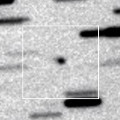
|
Now it is 16.9 mag (Dec. 22, Toshihiko Ikemura, Hirohisa Sato). It stays observable at 18 mag for a long time until 2019.
Date(TT) R.A. (2000) Decl. Delta r Elong. m1 Best Time(A, h)
Dec. 30 6 14.55 18 12.7 6.986 7.962 172 17.7 23:38 ( 0, 73)
Jan. 6 6 8.58 18 0.2 7.002 7.959 165 17.7 23:04 ( 0, 73)
|

|
Now it is 17.8 mag (Nov. 23, H. Nohara). It was observed at 17 mag in former 2017. It will be observable at 18 mag in good condition from winter to spring.
Date(TT) R.A. (2000) Decl. Delta r Elong. m1 Best Time(A, h)
Dec. 30 12 54.71 3 26.8 5.281 5.321 87 17.9 5:37 (339, 57)
Jan. 6 12 54.23 4 25.6 5.172 5.341 94 17.8 5:38 (353, 59)
|
|
![]()
![]()



































